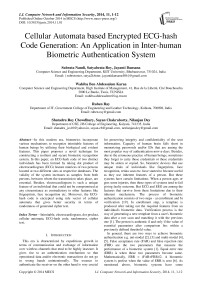Cellular Automata based Encrypted ECG-hash Code Generation: An Application in Inter human Biometric Authentication System
Автор: Subrata Nandi, Satyabrata Roy, Jayanti Dansana, Wahiba Ben Abdessalem Karaa, Ruben Ray, Shatadru Roy Chowdhury, Sayan Chakraborty, Nilanjan Dey
Журнал: International Journal of Computer Network and Information Security(IJCNIS) @ijcnis
Статья в выпуске: 11 vol.6, 2014 года.
Бесплатный доступ
In this modern era, biometrics incorporate various mechanisms to recognize inimitable features of human beings by utilizing their biological and evident features. This paper proposes a novel technique for constructing a resilient and secure biometric recognition system. In this paper, an ECG-hash code of two distinct individuals has been formed by taking dot product of electrocardiogram (ECG) feature matrices of two persons located at two different sites at respective databases. The validity of the system increases as samples from both persons, between whom the transmission takes place, are essential. Besides, electrocardiogram is such a unique feature of an individual that could not be compromised at any circumstance as contradictory to other features like fingerprints, face recognition etc. Moreover, the ECG-hash code is encrypted using rule vector of cellular automata that gives better security in terms of randomness of generated cipher text.
Inimitable, electrocardiogram, dot product, cellular automata, ECG-hash code, randomness, cipher text
Короткий адрес: https://sciup.org/15011354
IDR: 15011354
Список литературы Cellular Automata based Encrypted ECG-hash Code Generation: An Application in Inter human Biometric Authentication System
- M. Dey, N. Dey, S. K. Mahata, S. Chakraborty, S. Acharjee and A. Das, “Electrocardiogram Feature based Inter-human Biometric Authentication System”, International Conference on Electronic Systems, Signal Processing and Computing Technologies, 2014.
- S Latifi, N Solayappan, “A Survey of Unimodal Biometric Methods”, in International Conference on Security & Management, SAM, 2006, pp. 57-63.
- S. S. Parvinder, I. Kaur, A. Verma, S. Jindal, S. Singh. (2009, Nov.). Biometric Methods and Implementation of Algorithms. International Journal of Electrical & Electronics Engineering [Online].3,(8),pp.3-8.
- S. M. Rahal, H. A. Aboalsamah, K. N. Muteb, “Multimodal Biometric Authentication System – MBAS”, in 2nd IEEE Conference on Information and Communication Technologies, 2006, pp. 1026-1030.
- M. I. Ahmad, W. L. Woo, S. S. Dlay, “Multimodal biometric fusion at feature level: Face and palm print”, in 7th International Symposium on Communication Systems Networks and Digital Signal Processing, 2010, pp. 801-805.
- P. Lacharme, A. Plateaux. PIN-based cancelable biometrics, GREYC Research lab, Ensicaen - UCBN – CNRS [Online].3(2),. Available: http://www.ecole.ensicaen.fr/~lacharme/IJAIT2011.pdf. 2011, pp. 75-79
- N. Radha1 and S. Karthikeyan, “An Evaluation of Fingerprint Security using Noninvertible Biohash”, International Journal of Network Security & Its Applications (IJNSA), 2011, Vol.3, No.4.
- N. Dey, B. Nandi, M. Dey , D. Biswas, A. Das, S. S. Chaudhuri, “Generation of Bio Hash Code from Electrocardiogram Features”, in 3rd IEEE International Advance Computing Conference, 2013, pp. 724-728.
- F. Maleki, A. Mohades, M. E. Shiri, A. Bijari, " A CA randomizers based on parallem CAs with balanced rules", International conference on Computational Science, ICCS, 2010, pp. 417-425.
- L. Kotoulas, D. Tsarouchis, G. Ch. Sirakoulis, I. Andreadis, "1-d cellular automata for pseudo random number generation and its reconfigurable hardware implementation", Proceedings of IEEE international symposium on circuits and systems, 2006.
- S. Roy, S. Nandi, J. Dasnasa, P. K. Pattnaik, "Application of cellular automata in symmetric key cryptography", Proceedings of IEEE International Conference on Communication and Signal Processing (ICCSP), 2014.
- J. V. Neumann, Theory of Self Reproducing Automata, edited and completed by Burks, A.W. (Ed.), Univ. of Illinois press, London, 1966.
- S. Wolfram, A new kind of science, Wolfram Media Inc., ISBN: 1-57955-008-8, 2002.
- S. Nandi, B. K. Kar, Pabitra Pal Chaudhuri, “Theory and applications of cellular automata in cryptography”, IEEE Transactions on Computers, 1994, 43(12), pp. 1346-1356.
- D. Mukhopadhyay, "Design and analysis of cellular automata based cryptographic algorithms", Doctoral thesis, Indian Institute of Technology, Kharagpur, 2007.
- N. Dey, S. Mukhopadhyay, A. Das, S. S. Chaudhuri, “Analysis of P-QRS-T Components Modified by Blind Watermarking Technique Within the Electrocardiogram Signal for Authentication in Wireless Telecardiology Using DWT”, in IJIGSP, 2012, vol.4, no.7, pp.33-46.
- N. Dey, S. Samanta, X-S Yang, A. Das, and S. S. Chaudhuri, “Optimisation of scaling factors in electrocardiogram signal watermarking using cuckoo search’, Int. J. Bio-Inspired Computation, 2013, Vol. 5, No. 5, pp.315–326
- S. M. Ross, Introductory Statistics, Second edition, Academic Press, Elsevier, pp. 659-664.
- N. Dey, A. B. Roy, A. Das and S. S. Chaudhuri, “Recent Trends in Computer Networks and Distributed Systems Security”, published in Springer Berlin / Heidelberg in Communications in Computer and Information Science, 2012, ISBN 978-3-642-34134-2, Volume 335, Part 2, Pages 347-357, DOI: 10.1007/978-3-642-34135-9_35.
- N. Dey, S. Biswas , A. B. Roy, A. Das and S.S. Chaudhuri, “Analysis Of Photoplethysmographic Signals Modified by Reversible Watermarking Technique using Prediction-Error in Wireless Telecardiology”, International Conference of Intelligent Infrastructure, 47th Annual National Convention of CSI, 2012, McGraw-Hill Proceeding .
- N. Dey, P. Das, A. Das and S.S. Chaudhuri, “DWT-DCT-SVD Based Blind Watermarking Technique of Gray Scale Image in Electrooculogram Signal”, International Conference on Intelligent Systems Design and Applications (ISDA-2012), pp. 680-685, 2012.
- N. Dey, S. Biswas, P. Das, A. Das, and S. S. Chaudhuri, “Feature Analysis for the Reversible Watermarked Electrooculography Signal using Low Distortion Prediction-error Expansion”, 2012 International Conference on Communications, Devices and Intelligent Systems (CODIS), pp.624-627, 2012.


